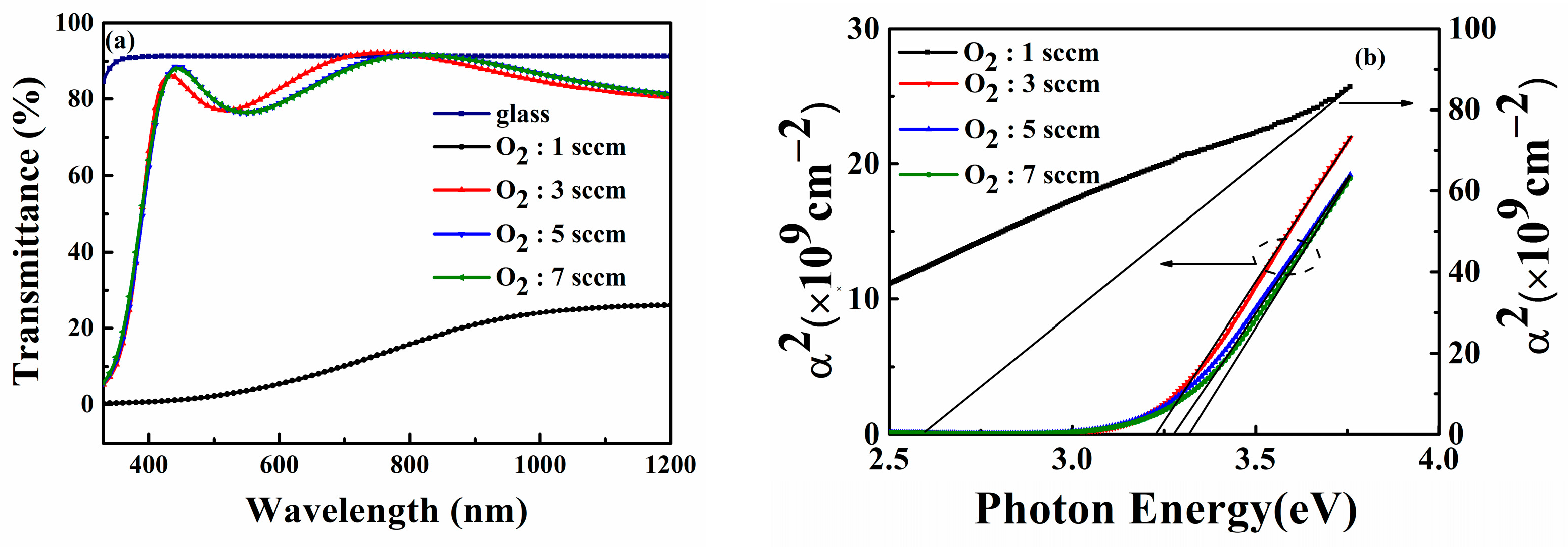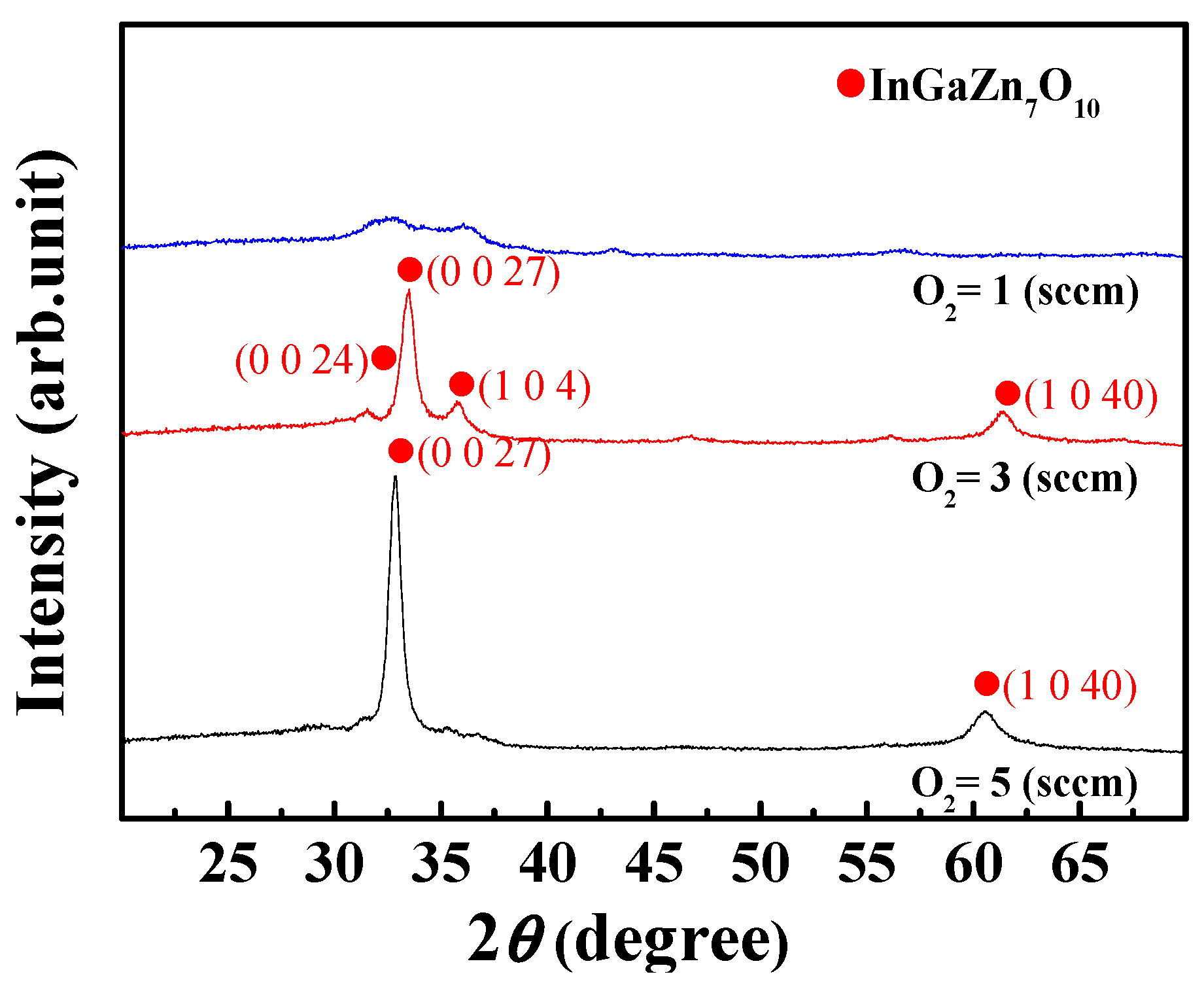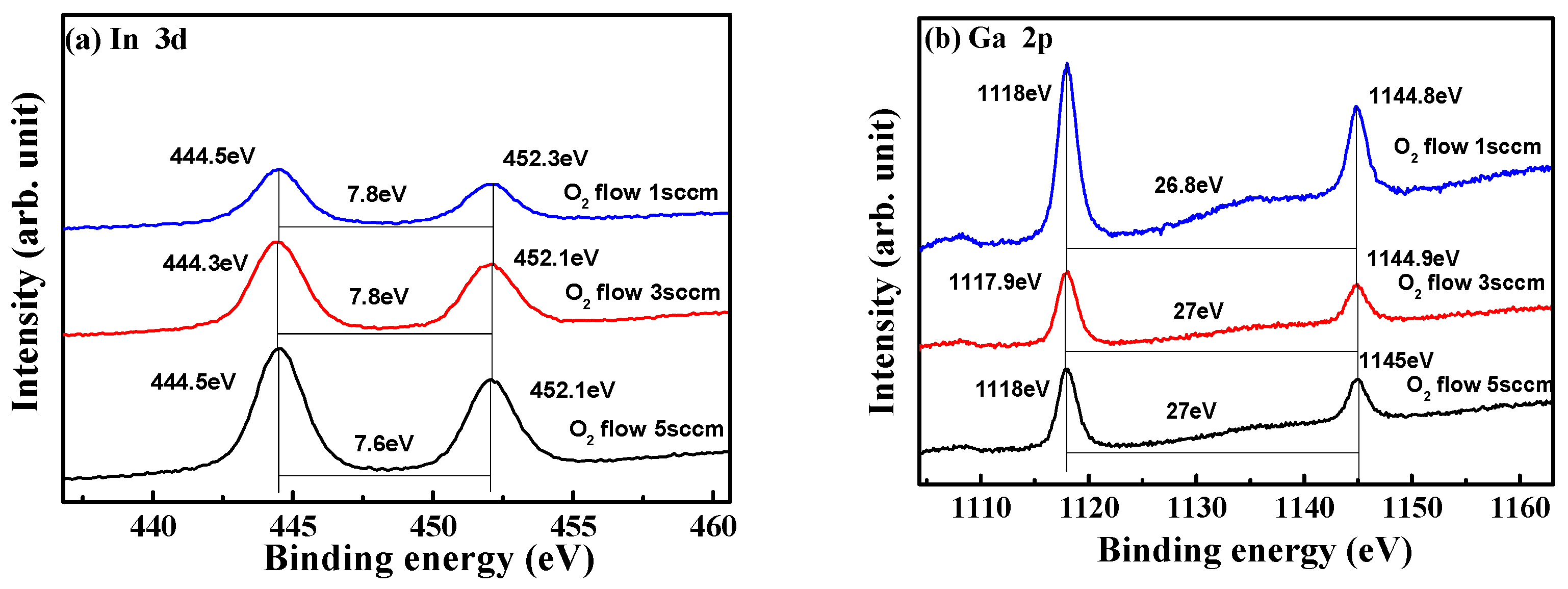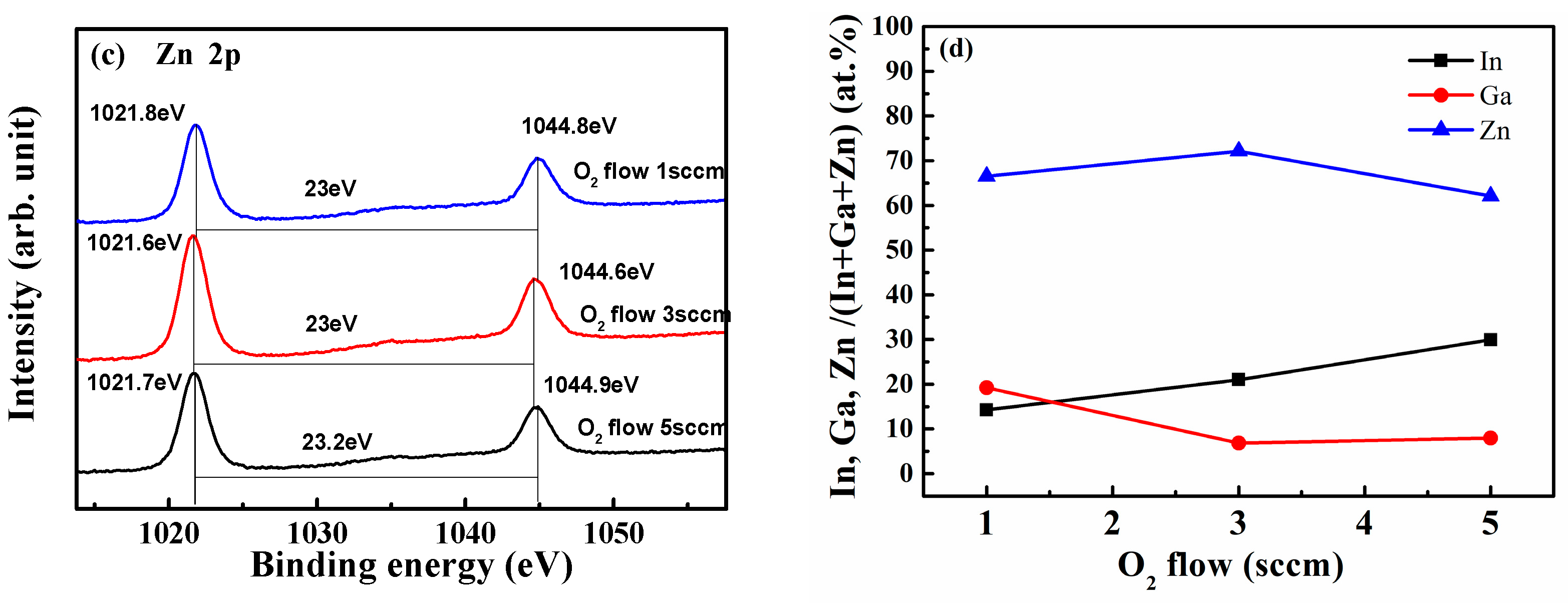Effects of Oxygen Flows and Annealing Temperatures on Optical, Electrical, and Structural Properties of Co-Sputtered In2O3-Ga2O3-Zn Thin Films
Abstract
:1. Introduction
2. Materials and Methods
3. Results and Discussion
3.1. Optical and Electrical Properties of Cosputtered IGZO Films at Different Oxygen Flow Rates
3.2. Structural Analysis of Co-Sputtered IGZO Thin Films at Different Oxygen Flow Rates
3.3. X-ray Photoelectron Spectroscop (XPS) ic Analysis of Co-Sputtered IGZO Thin Films
4. Conclusions
Author Contributions
Funding
Data Availability Statement
Acknowledgments
Conflicts of Interest
References
- Takagi, A.; Nomura, K.; Ohta, H.; Yanagi, H.; Kamiya, T.; Horano, M.; Hosono, H. Carrier transport and electronic structure in amorphous oxide semiconductor, a-InGaZnO4. Thin Solid Films 2005, 486, 38–41. [Google Scholar] [CrossRef]
- Hosono, H.; Kim, S.W.; Miyakawa, M.; Matsuishi, S.; Kamiya, T. Thin film and bulk fabrication of room-temperature-stable electride C12A7:e− utilizing reduced amorphous 12CaO·7Al2O3 (C12A7). J. Non-Cryst. Solids 2008, 354, 2772–2776. [Google Scholar] [CrossRef]
- Yang, S.; Cho, D.H.; Ryu, M.K.; Park, S.H.K.; Hwang, C.S.; Jang, J.; Jeong, J.K. High-Performance Al–Sn–Zn–In–O Thin-Film Transistors: Impact of Passivation Layer on Device Stability. IEEE Electron Device Lett. 2010, 31, 144–146. [Google Scholar] [CrossRef]
- Cho, D.H.; Yang, S.H.; Byun, C.W.; Shin, J.H.; Ryu, M.K.; Park, S.H.K.; Hwang, C.S.; Chung, S.M.; Cheong, W.S.; Yoon, S.M.; et al. Transparent Al–Zn–Sn–O thin film transistors prepared at low temperature. Appl. Phys. Lett. 2008, 93, 142111. [Google Scholar] [CrossRef]
- Nomura, K.; Ohta, H.; Takagi, A.; Kamiya, T.; Hirano, M.; Hosono, H. Room-temperature fabrication of transparent flexible thin-film transistors using amorphous oxide semiconductors. Nature 2004, 432, 488–492. [Google Scholar] [CrossRef] [PubMed]
- Hosono, H. Ionic amorphous oxide semiconductors: Material design, carrier transport, and device application. J. Non-Cryst. Solids 2006, 352, 851–858. [Google Scholar] [CrossRef]
- Yabuta, H.; Sano, M.; Abe, K.; Aiba, T.; Den, T.; Kumomi, H.; Nomura, K.; Kamiya, T.; Hosono, H. High-mobility thin-film transistor with amorphous InGaZnO4 channel fabricated by room temperature RF magnetron sputtering. Appl. Phys. Lett. 2006, 89, 112123. [Google Scholar] [CrossRef]
- Nomura, K.; Takagi, A.; Kamiya, T.; Ohta, H.; Hirano, M.; Hosono, H. Amorphous Oxide Semiconductors for High Performance Flexible Thin-Film Transistors. Jpn. J. Appl. Phys. 2006, 45, 4303–4308. [Google Scholar] [CrossRef]
- Jeong, J.K.; Yang, H.W.; Jeong, J.H.; Mo, Y.G.; Kim, H.D. Origin of threshold voltage instability in indium-gallium-zinc oxide thin film transistors. Appl. Phys. Lett. 2008, 93, 123508. [Google Scholar] [CrossRef]
- Park, J.S.; Jeong, J.K.; Chung, H.J.; Mo, Y.G.; Kim, H.D. Electronic transport properties of amorphous indium-gallium-zinc oxide semiconductor upon exposure to water. Appl. Phys. Lett. 2008, 92, 072104. [Google Scholar] [CrossRef]
- Miyasako, T.; Senoo, M.; Tokumitsu, E. Ferroelectric-gate thin-film transistors using indium-tin-oxide channel with large charge controllability. Appl. Phys. Lett. 2005, 86, 162902. [Google Scholar] [CrossRef]
- Dehuff, N.L.; Kettenring, E.S.; Hong, D.; Chiang, H.Q.; Wager, J.F.; Hoffman, R.L.; Park, C.H.; Keszler, D.A. Transparent thin-film transistors with zinc indium oxide channel layer. J. Appl. Phys. 2005, 97, 064505. [Google Scholar] [CrossRef]
- Yaglioglu, B.; Yeom, H.Y.; Beresford, R.; Paine, D.C. High-mobility amorphous In2O3–10wt%ZnO thin film transistors. Appl. Phys. Lett. 2006, 89, 062103. [Google Scholar] [CrossRef]
- Barquinha, P.; Goncalves, G.; Pereira, L.; Martins, R.; Fortunato, E. Effect of annealing temperature on the properties of IZO films and IZO based transparent TFTs. Thin Solid Films 2007, 515, 8450–8454. [Google Scholar] [CrossRef]
- Park, S.H.K.; Hwang, C.S.; Ryu, M.K.; Yang, S.H.; Byun, C.W.; Shin, J.H.; Lee, J.I.; Lee, K.M.; Oh, M.S.; Im, S.I. Transparent and Photo-Stable ZnO Thin-Film Transistors to Drive an Active Matrix Organic-Light-Emitting-Diode Display Panel. Adv. Mater. 2009, 21, 678–682. [Google Scholar]
- Hoffman, R.L. Effects of channel stoichiometry and processing temperature on the electrical characteristics of zinc tin oxide thin-film transistors. Solid-State Electron. 2006, 50, 784–787. [Google Scholar] [CrossRef]
- Iwasaki, T.; Itagaki, N.; Den, T.; Kumomi, H. Combinatorial approach to thin-film transistors using multicomponent semiconductor channels: An application to amorphous oxide semiconductors in In–Ga–Zn–O system. Appl. Phys. Lett. 2007, 90, 242114. [Google Scholar] [CrossRef]
- Koinuma, H.; Takeuchi, I. Combinatorial solid-state chemistry of inorganic materials. Nat. Mater. 2004, 3, 429–438. [Google Scholar] [CrossRef]
- Bak, J.Y.; Yang, S.; Yoon, S.M. Transparent Al–In–Zn–O Oxide semiconducting films with various in composition for thin-film transistor applications. Ceram. Int. 2013, 39, 2561–2566. [Google Scholar] [CrossRef]
- Jeon, H.; Na, S.; Moon, M.R.; Jung, D.; Kim, H.; Lee, H.J. The Effects of Zn Ratio on the Microstructure Electrical Properties of InGaZnO Films. J. Electrochem. Soc. 2011, 158, H949–H954. [Google Scholar] [CrossRef]
- Choi, S.-H. High-Performance Oxide TFTs with Co-Sputtered Indium Tin Oxide and Indium-Gallium-Zinc Oxide at Source and Drain Contacts. IEEE Electron Device Lett. 2021, 42, 168–171. [Google Scholar] [CrossRef]
- Park, K.; Kim, J.H.; Sung, T.; Park, H.-W.; Baeck, J.-H.; Bae, J.; Park, K.-S.; Yoon, S.; Kang, I.; Chung, K.-B.; et al. Highly Reliable Amorphous In-Ga-Zn-O Thin-Film Transistors through the Addition of Nitrogen Doping. IEEE Trans. Electron Devices 2019, 66, 457–462. [Google Scholar] [CrossRef]
- Cai, W.; Wilson, J.; Zhang, J.; Brownless, J.; Zhang, X.; Majewski, L.A.; Song, A. Significant Performance Enhancement of Very Thin InGaZnO Thin-Film Transistors by a Self-Assembled Monolayer Treatment. ACS Appl. Electron. Mater. 2020, 2, 301–308. [Google Scholar] [CrossRef]
- Hong, T.H.; Kim, Y.-S.; Choi, S.-H.; Lim, J.H.; Park, J.-S. Exploration of Chemical Composition of In-Ga-Zn-O System via PEALD Technique for Optimal Physical and Electrical Properties. Adv. Electron. Mater. 2023, 9, 2201208. [Google Scholar] [CrossRef]
- Lee, Y.S.; Chang, C.H.; Lin, Y.C.; Lyu, R.J.; Lin, H.C.; Huang, T.Y. Effects of Ga2O3 deposition power on electrical properties of cosputtered In–Ga–Zn–O semiconductor films and thin-film transistors. Jpn. J. Appl. Phys. 2014, 53, 05HA02. [Google Scholar] [CrossRef]
- Lee, Y.S.; Wang, C.W.; Lin, Y.C.; Jaing, C.C. Effects of ZnO composition on structure, optical and electrical properties of cosputtering In2O3–Ga2O3–ZnO films. J. Mat. Sci. Mat. Electron. 2016, 27, 11470–11477. [Google Scholar] [CrossRef]
- Lee, Y.-S.; Zhao, S.Y.; Lin, Y.Z.; Porter, G.A. Effects of oxygen flows and annealing temperature on properties of cosputtering In2O3-Ga2O3-Zn thin films. In Proceedings of the Compound Semiconductor Week (CSW), Toyama, Japan, 26–30 June 2016. [Google Scholar]
- Chen, X.F.; He, G.; Liu, M.; Zhang, J.W.; Deng, B.; Wang, P.H.; Zhang, M.; Lv, J.G.; Sun, Z.Q. Modulation of optical and electrical properties of sputtering-derived amorphous InGaZnO thin films by oxygen partial pressure. J. Alloys Compd. 2014, 615, 636–642. [Google Scholar] [CrossRef]
- Lee, Y.S.; Dai, Z.-M.; Lin, C.-I.; Lin, H.-C. Relationships between the crystalline phase of an IGZO target and electrical properties of a-IGZO channel film. Ceram. Int. 2012, 38, S595–S599. [Google Scholar] [CrossRef]
- Matsubara, K.; Fons, P.; Iwata, K.; Yamada, A.; Niki, S. Room-temperature deposition of Al-doped ZnO films by oxygen radical assisted pulsed laser deposition. Thin Solid Films 2002, 422, 176–179. [Google Scholar] [CrossRef]
- Beena, D.; Lethy, K.J.; Vinodkumar, R.; Mahadevan Pillai, V.P.; Ganesan, V.; Phase, D.M.; Sudheer, S.K. Effect of substrate temperature on structural, optical and electrical properties of pulsed laser ablated nanostructured indium oxide films. Appl. Surf. Sci. 2009, 255, 8334–8342. [Google Scholar] [CrossRef]
- Tang, Z.K.; Wong, G.K.L.; Yu, P.; Kawasaki, M.; Ohtomo, A.; Koinuma, H.; Segawa, Y. Room-temperature ultraviolet laser emission from self-assembled ZnO microcrystallite thin films. Appl. Phys. Lett. 1998, 72, 3270–3272. [Google Scholar] [CrossRef]
- Minegishi, K.; Koiwai, Y.; Kikuchi, Y. Growth of p-type Zinc Oxide Films by Chemical Vapor Deposition. Jpn. J. Appl. Phys. 1997, 36, L1453. [Google Scholar] [CrossRef]
- Bender, M.; Katsarakis, N.; Gagaoudakis, E.; Hourdakis, E.; Douloufakis, E.; Cimalla, V.; Kiriakidis, G. Dependence of the photoreduction and oxidation behavior of indium oxide films on substrate temperature and film thickness. J. Appl. Phys. 2001, 90, 5382–5387. [Google Scholar] [CrossRef]
- Carcia, P.F.; Maclean, R.F.; Reilly, M.H.; Nunes, G. Transparent ZnO thin-film transistor fabricated by rf magnetron sputtering. Appl. Phys. Lett. 2003, 82, 1117–1119. [Google Scholar] [CrossRef]
- Liu, W.T.; Liu, Z.T.; Yan, F.; Tan, T.T.; Tian, H. Influence of O2/Ar flow ratio on the structure and optical properties of sputtered hafnium dioxide thin films. Surf. Coat. Technol. 2010, 205, 2120–2125. [Google Scholar] [CrossRef]
- Song, D.; Windenborg, P.; Chin, W.; Aberle, A. Investigation of lateral parameter variations of Al-doped zinc oxide films prepared on glass substrates by RF magnetron sputtering. Sol. Energy Mater. Sol. Cells 2002, 73, 1–20. [Google Scholar] [CrossRef]
- Chen, J.; Wang, L.; Su, X.; Kong, L.; Liu, G.; Zhang, X. InGaZnO semiconductor thin film fabricated using pulsed laser deposition. Opt. Exp. 2010, 18, 1398–1404. [Google Scholar] [CrossRef]
- Hado, G.M.; Guerra, D.N.; Leinen, D.; Ramos-Barrado, D.J.; Marotti, R.E.; Dalchiele, E.A. Indium doped zinc oxide thin films obtained by electrodeposition. Thin Solid Films 2005, 490, 124–131. [Google Scholar]
- Kim, G.H.; Kim, H.S.; Shin, H.S.; Ahn, B.D.; Kim, K.H.; Kim, H.J. Inkjet-printed InGaZnO thin film transistor. Thin Solid Films 2009, 517, 4007–4010. [Google Scholar] [CrossRef]
- Chen, J.; Wang, L.; Su, X.; Wang, R. Pulsed laser deposited InGaZnO thin film on silica glass. J. Non-Cryst. Solids 2012, 358, 2466–2469. [Google Scholar] [CrossRef]










Disclaimer/Publisher’s Note: The statements, opinions and data contained in all publications are solely those of the individual author(s) and contributor(s) and not of MDPI and/or the editor(s). MDPI and/or the editor(s) disclaim responsibility for any injury to people or property resulting from any ideas, methods, instructions or products referred to in the content. |
© 2023 by the authors. Licensee MDPI, Basel, Switzerland. This article is an open access article distributed under the terms and conditions of the Creative Commons Attribution (CC BY) license (https://creativecommons.org/licenses/by/4.0/).
Share and Cite
Lee, Y.-S.; Zhao, S.-Y.; Lin, Y.-Z.; Porter, G.A.; Tien, T.-C. Effects of Oxygen Flows and Annealing Temperatures on Optical, Electrical, and Structural Properties of Co-Sputtered In2O3-Ga2O3-Zn Thin Films. Crystals 2023, 13, 1310. https://doi.org/10.3390/cryst13091310
Lee Y-S, Zhao S-Y, Lin Y-Z, Porter GA, Tien T-C. Effects of Oxygen Flows and Annealing Temperatures on Optical, Electrical, and Structural Properties of Co-Sputtered In2O3-Ga2O3-Zn Thin Films. Crystals. 2023; 13(9):1310. https://doi.org/10.3390/cryst13091310
Chicago/Turabian StyleLee, Yih-Shing, Sheng-Yu Zhao, Yuan-Zhe Lin, Glen Andrew Porter, and Tsung-Cheng Tien. 2023. "Effects of Oxygen Flows and Annealing Temperatures on Optical, Electrical, and Structural Properties of Co-Sputtered In2O3-Ga2O3-Zn Thin Films" Crystals 13, no. 9: 1310. https://doi.org/10.3390/cryst13091310
APA StyleLee, Y.-S., Zhao, S.-Y., Lin, Y.-Z., Porter, G. A., & Tien, T.-C. (2023). Effects of Oxygen Flows and Annealing Temperatures on Optical, Electrical, and Structural Properties of Co-Sputtered In2O3-Ga2O3-Zn Thin Films. Crystals, 13(9), 1310. https://doi.org/10.3390/cryst13091310





